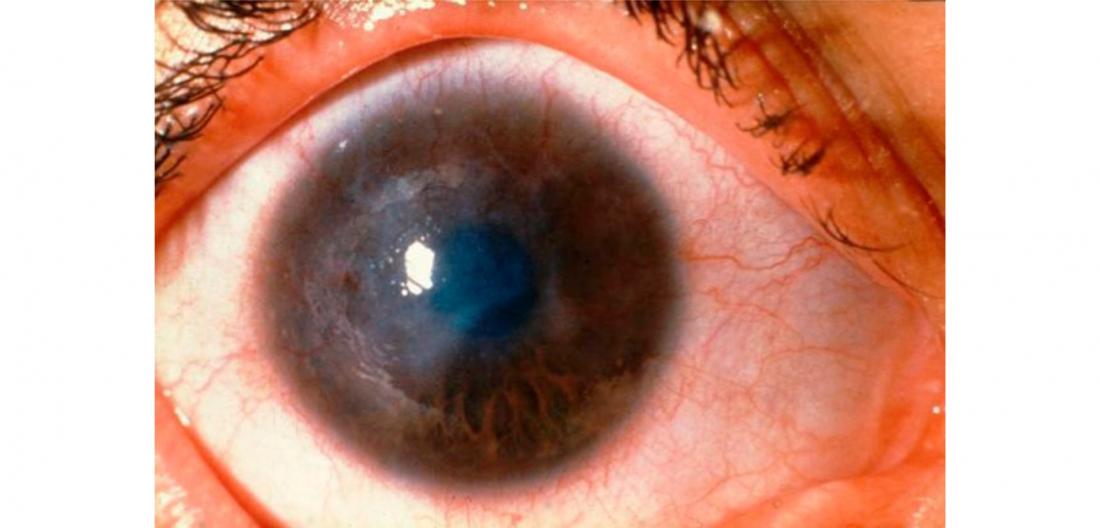Rheumatoid arthritis (RA) is an autoimmune disease that causes inflammation in the joints. When a person has RA, the synovium, which is the protective lining of the joints, grows much thicker, resulting in pannus.
In this article, we look at the link between pannus and RA. We also discuss the treatments, complications, and outlook.
What is pannus?

Pannus is an abnormal tissue growth that can form in the eye.
Image Credit: Wellcome Collection. CC0.
Pannus is an abnormal tissue growth caused by thickening of the synovium.
RA causes the body to release proteins called cytokines.
Cytokines cause new blood vessels to develop in the synovium, causing the growth of extra tissues. This tissue then eventually forms pannus.
As pannus develops, it takes up more space in the joint. Small, hair-like growths called villi also develop on the pannus, making its surface rough and uneven.
Pannus also releases harmful enzymes, acids, and proteins that can damage the bone and cartilage within a joint. These growths are painful and may lead to permanent damage and reduced mobility in the joint.
A review found that damage to the cartilage around the joints is more likely to cause permanent joint damage and disability in people with RA than damage to the bone will.
Pannus may cause the joint to produce excess fluid. The synovium requires small amounts of fluids to lubricate the joint. The fluid also helps to reduce friction and protect the joint from impact damage. However, in large quantities, fluid can cause swelling and pain in the area.
Pannus can also form in other areas in the body, such as in the eye or abdomen.
Pannus in people with osteoarthritis appears to cause less damage to the surrounding joint than it does in people who have RA. Researchers are not sure why this is, as pannus in both conditions has a similar structure.
Treatment
RA is caused by an overactive immune system that mistakenly attacks its own tissue, sometimes leading to the formation of pannus.
Currently, there is no cure for RA and pannus, but treatments can help manage symptoms and slow down or stop the progression of the condition.
Treatment for RA aims to reduce pain, manage symptoms, and improve a person’s mobility.
Treatments include:
- Non-steroidal anti-inflammatory drugs (NSAIDs) can reduce inflammation in the joints, which relieves swelling, pain, and stiffness. They can also improve mobility in the joint.
- Disease-modifying anti-rheumatic drugs (DMARDs) help to suppress the immune system. This may reduce joint damage and slow the development of the pannus.
- Doctors may prescribe fast-acting biological therapies instead of, or alongside, DMARDs. For example, a drug called rituximab may decrease the number of harmful antibodies released by white blood cells in people with RA.
If a person needs immediate treatment, doctors might inject a steroid medication into the joint. This can reduce the growth of pannus. However, this procedure may cause side effects, so doctors do not always recommend this treatment.
Physical therapy can also help with RA symptoms. Regular stretches and exercise can help keep a person’s joints healthy and improve mobility.
In severe cases, a doctor may recommend surgery to remove, replace, or fuse bones together to prevent further damage and reduce pain in the damaged joint.
Complications

Pannus can result in severe pain and joint stiffness.
The growth of pannus in people with RA can cause lasting damage to the joint, bone, and tissue.
This can lead to severe pain, joint stiffness, and mobility issues.
Along with pannus, RA can cause the following symptoms:
People with RA may also experience more extensive complications. The risk of these complications increases with age as the disease progresses. According to the Centers for Disease Control and Prevention, the highest rate of RA is in people aged over 60 years old.
People with RA are at an increased risk of:
Outlook
In the earlier stage of arthritis, medication can slow down the growth of pannus. People may still experience symptoms, such as inflammation and joint pain, but the joint can remain functional.
Over time, pannus can grow and become a more severe problem. It can cause pain, swelling, and stiffness in the joint. This can affect joint mobility and potentially cause permanent damage.
Treatments and outlook for people with RA have improved significantly. Medications can help people manage their symptoms and reduce or stop the progression of the condition.
